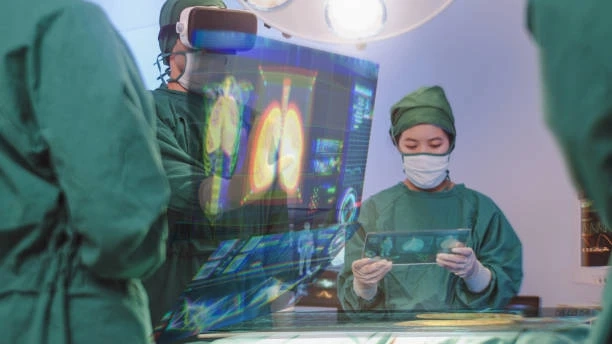In the world of healthcare, VR has taken center stage with its incredible applications. It has completely transformed the way we approach medical treatment, therapy, and education, transcending the boundaries of conventional methods and opening a world of possibilities. In this blog, we will dive into the impact of Virtual reality in healthcare and how it has changed the whole sector.
Applications of Virtual Reality in Healthcare
Here are the applications of Virtual Reality in health that make the use of medical VR a success-
VR in Pain Management
In healthcare, pain management has always presented challenges. But with VR in healthcare, the patient with chronic pain or those who have undergone medical procedures can now be distracted thus, transcending the traditional limits of pain management techniques.
It's time to leave those white walls of the hospital room.
VR is able to create a highly immersive and captivating virtual world for patients where they are engaged in serene activities. They will lose themselves in a world full of captivating stories or in a peaceful environment escaping the discomfort and anxiety involved in the traditional medical procedures.
But, what is more interesting is its ability to significantly reduce pain perception and anxiety levels. According to the research, patients who have used VR while undergoing medical procedures have seen a remarkable decrease in the intensity of the pain they go through.
Well, this mechanism is multifaceted. It is able to distract the patients’ minds by diverting them from physical sensations that trigger discomfort. It elicits the sense of being present in the physical world which can serve as a powerful analgesic. It is highly beneficial for the patients who have physical sensations that trigger discomfort.
Physical and Occupational Therapy
While healing, physical and occupational therapy are the vital components that help individuals to recover from injuries, surgeries, or managing chronic conditions.
With the integration of VR in healthcare, a new life is breathed into these therapies.
But how?
Well with specially designed virtual reality applications and headsets, patients are allowed to step into a captivating digital room where the rehabilitation process is converted into an immersive experience.
While engaging with the immersive virtual environment, the patients can perform their exercises with renewed enthusiasm. What is interesting to know is that the therapeutic activities are seamlessly integrated into the VR experience, making them feel like exciting challenges rather than mundane routines.
With the involvement of gamification in therapy, the patients are no longer counting down the minutes until their session ends, instead, they engage themselves in the virtual world. With VR therapy they can feel a sense of achievement while surpassing their own milestones. Think of beating their own high score and completing the virtual quest.
And who would want to skip such sessions?
Patients will themselves look forward to their therapy sessions. With such motivation and adherence, patients experience faster progress and regain their physical abilities sooner than expected with traditional therapy.
It not only helps them recover faster but also encourages patients to maintain healthier habits beyond their recovery, promoting a long-term, improved quality of life.
Mental Health and Exposure Therapy
For those individuals who are suffering from phobia and post-traumatic stress disorder (PTSD), VR has become a transformative tool. Exposure therapy, a proven method for addressing these conditions, has found a new home in the immersive virtual environment, redefining the way we approach treatment.
In the traditional form, the exposure therapy, patients have to face their fears or traumatic memories in the real world. This was an effective technique but it can drain emotions. With the use of VR, patients can confront their fears in a controlled and immersive setting without any fear of real-world exposure.
Education and Training
How can forget VR’s impact on educating and training healthcare professionals?
For medical students and budding surgeons, the ability to practice surgical procedures in a risk-free virtual setting is just extraordinary. In the past, mastering surgical skills with the traditional educational system often came at the expense of patients' well-being. But with VR training in healthcare, learners can now step into a highly realistic, virtual operating room. They can meticulously practice techniques, perfect their dexterity, and make mistakes without real-world consequences.
With VR for surgery training, medical students can familiarize themselves with the intricacies of the procedure, learn the right steps, and develop muscle memory. The immersive experience of VR helps reduce the steep learning curve and builds confidence that can be transferred to the operating room.
Challenges and Future Possibilities
While the impact of virtual reality in science education is remarkable, it's not without its challenges.
Issues such as the cost of VR equipment, data privacy, and the need for regulatory standards need to be addressed. Nonetheless, as technology continues to advance, these barriers are likely to diminish.
Looking forward, the potential applications of VR in healthcare are vast. Imagine a future where surgeries are performed remotely with precision, or where patients with severe mobility issues can explore the world virtually. The possibilities are limited only by our imagination and innovation.
Conclusion
In conclusion, we can say that VR has completely changed the ways we could have dreamt of a few years ago.
From pain management and therapy to medical education and telemedicine, VR is pushing the boundaries of what's possible in healthcare. As the technology matures and becomes more accessible, its impact on patient care and medical practice will only continue to grow.


